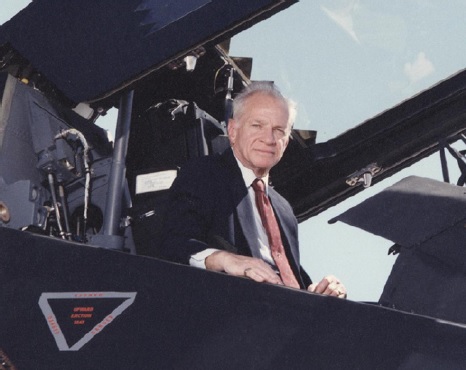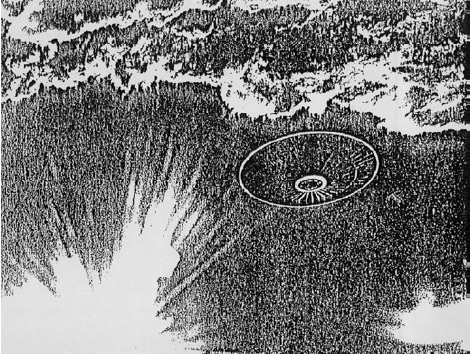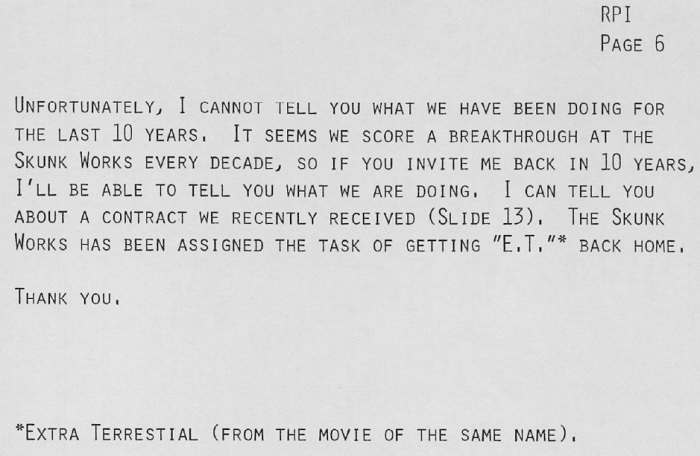.
Taking E.T. Home: Birth of a Modern Myth / By Peter W. Merlin
.
One of the world’s foremost aeronautical engineers stunned UFO researchers by apparently admitting personal knowledge of technology for interstellar travel during a March 1993 lecture at the University of California, Los Angeles. Jan Harzan, now executive director of Mutual UFO Network (MUFON), attended the event and shared his story in a January 2012 interview with Web Talk Radio Network, and again with Alejandro Rojas of Open Minds UFO News and Investigations in July 2013. Harzan said he attended the presentation with fellow UCLA engineering alumnus and UFO enthusiast Tom Keller because the featured speaker was Ben R. Rich, former president of Lockheed’s Advanced Development Projects (ADP) division that is best known as the Skunk Works and has a reputation for developing cutting-edge aerospace technology.
Rich had a long and distinguished career highlighted by his involvement with designing the world’s highest-flying and fastest jet aircraft, and others that redefined the future of military aviation. After working in Lockheed’s main plant in Burbank for several years, he joined the Skunk Works group in 1954 as a thermodynamicist on the XF-104 project where he helped design a prototype jet-powered interceptor capable of speeds in excess of 1,300 miles per hour. He later served as senior design engineer for the U-2 high-altitude reconnaissance plane, and helped develop the Blackbird family of high-speed aircraft that included the A-12, YF-12, and SR-71. In 1975, he became head of ADP and oversaw development of several of the very first stealth vehicles, aircraft that were virtually invisible to radar detection. Nearly all of the programs he worked on began as top-secret, special-access “black” projects that were tested at the infamous Area 51 in Nevada, focus of much UFO lore.
Rich was a member of the National Academy of Engineering and winner of numerous awards including the 1989 Collier Trophy and Department of Defense Medal for Distinguished Public Service. He retired from Lockheed ADP in 1990, but continued to serve as a consultant for government and industry. Throughout his career and after retirement, until shortly before his death from cancer in January 1995, he traveled the country giving presentations on the accomplishments of the Skunk Works.

“Joke ‘em if they can’t take a…”
His lecture at the 1993 UCLA alumni meeting was well attended. Harzan and Keller joined an audience that by Harzan’s account included some 200 engineers. During his presentation Rich showed about two-dozen slides highlighting many of the aircraft he had worked on, and dropped tantalizing hints about projects as yet unrevealed to the public. Toward the end he discussed the stealthy F-117A that was secretly flown for the first time in June 1981 but had not been unveiled by the Defense Department until November 1988, several years after achieving operational capability. He also spoke of the YF-22, a technology demonstrator that in 1991 had been named winner of the Advanced Tactical Fighter competition and served as a prototype for the F-22A Raptor. Further tantalizing the audience, Rich alluded to Lockheed’s continuing efforts in the development of advanced aircraft technologies but expressed regret that he could not discuss them. “He intimated that there was a lot of other stuff going on that he could not talk about,” said Harzan.
Rich then showed his final slide, a picture of a disk-shaped craft – the classic “flying saucer” – flying into a partly cloudy sky with a burst of sunlight in the background. According to Harzan, Rich ended his speech by claiming “We now have the technology to take E.T. home.” The crowed laughed at this, as they were no doubt meant to, but Harzan and Keller were shocked. “Did he really just say that, and are these people really not getting that what he is saying is real?”

Well, the short answer is, no, he did not say that, not precisely. What Keller, an aerospace engineer who has worked as a computer systems analyst for NASA’s Jet Propulsion Laboratory, subsequently misquoted in the May 2010 issue of MUFON UFO Journal had become Rich’s standard tag line. It was a joke he had carefully honed over the span of a decade, ever since a homely little alien endeared itself to movie audiences across the globe.
When Steven Spielberg’s E.T. the Extraterrestrial was released in the United States on June 11, 1982, it opened at number one with a box office gross of $11 million, and stayed at the top for six weeks. By 1983, the film about a young boy befriending a lost visitor from space and helping the alien get home had superseded Star Wars as the highest-grossing film of all-time. The term “E.T.” inevitably entered the general lexicon, and became what today would be called a meme, an idea spread from person to person within a culture. Standout images from the movie, such as the alien’s glowing fingertip and a flying bicycle silhouetted against the full moon, were repeated in myriad forms and often parodied. Rich apparently decided to capitalize on this popularity, or perhaps the term had simply become embedded in his own psyche.
.

By the spring of 1983, he had added the flying saucer picture to the end of a set of between 12 and 25 slides that he showed with his lecture. Rich had long used a standard script for his talks, tailoring the content as necessary to accommodate his audience. Since most Skunk Works current projects were classified, it didn’t matter whether he was addressing school children or professional aeronautical engineers; he always ended the same way.
“Unfortunately, I cannot tell you what we have been doing for the last 10 years,” he opined at a Defense Week symposium on future space systems in Washington, D.C., on September 20, 1983. “It seems we score a breakthrough at the Skunk Works every decade, so if you invite me back in 10 years I’ll be able to tell you what we are doing [now].” Having set the bait, he prepared to reel in his hook. “I can tell you about a contract we recently received,” he intoned solemnly. Every ear in the room pricked up. The silence was palpable. “The Skunk Works has been assigned the task of getting E.T. back home.” Laughter followed.
This was precisely the reaction Rich expected and hoped for since he began using the gag, at least as early as April 1983 during a presentation at Rensselaer Polytechnic Institute in Troy, New York. If something is successful, it is worth repeating. Rich gave a nearly identical speech at the U.S. Naval Academy, Annapolis, Maryland, on September 6, 1984, and continued using his script during successive appearances. Sometimes he refined the details a bit. “I wish I could tell you what else we are doing in the Skunk Works,” he said, wrapping up a presentation for the Beverly Hills chapter of the National Society of Daughters of the American Revolution on May 23, 1990. “You’ll have to ask me back in a few years. I will conclude by telling you that last week we received a contract to take E.T. back home.”
Three years later he was still using the same line and the same slide. “We did the F-104, C-130, U-2, SR-71, F-117 and many other programs that I can’t talk about,” he proclaimed during a 1993 speech at Wright-Patterson Air Force Base, Ohio, home of Air Force Materiel Command, the organization responsible for all flight-testing within the Air Force. “We are still working very hard; I just can’t tell you what we are doing.” As usual, he added his by now infamous punch line, “The Air Force has just given us a contract to take E.T. back home.”
.
A Myth is Born
Few people noticed Rich’s little joke until it caught the attention of Harzan and Keller during the UCLA presentation. Harzan now says that after the lecture ended a few people remained behind to ask questions. Some wanted to know more about the technology to “take E.T. home.” Harzan says Rich initially brushed off these queries but eventually told one engineer, “We now know how to travel to the stars. We found an error in the equations and it won’t take a lifetime to do it.” Not surprisingly, this response spurred more questions. “He didn’t say what the equations were.” Harzan lamented, “I’m assuming they are Maxwell’s equations [on the generation of electrical and magnetic fields, and which form the basis of theories involving quantum electrodynamics].” As things began to wind down, Rich said, “I’ve got to go now,” and started to walk out of the room. Harzan pursued him, and continued to question him on the workings of interstellar propulsion systems. Rich finally stopped and turned, then said to Harzan, “Well, let me ask you; how does ESP work?” Stunned, Harzan considered the question and finally stammered, “I don’t know. All points in space and time are connected?” Rich responded, “That’s how it works,” then abruptly turned and walked away.
Harzan and others have interpreted Rich’s final comments as tacit admission that interstellar propulsion technology exists, that it is in the hands of U.S. scientists, and that it involves a specific set of known equations. But, taken in context, it sounds more like Rich knew he had carried his joke too far and talked himself into a corner. It is likely that he would have said, “That’s how it works,” no matter what Harzan’s answer had been. Even if Rich had said, “Look, I was just kidding,” it would have done no good. The damage was done.
Within the UFO community, Rich’s words, and additional statements attributed to him without corroborative proof, have become gospel. He is named as having admitted that extraterrestrial UFO visitors are real and that the U.S. military has interstellar capabilities, and although nearly two full years passed between Rich’s UCLA speech and his death in 1995, some believers have touted his comments as a “deathbed confession.” According to one un-sourced quote, Rich allegedly stated, “We already have the means to travel among the stars, but these technologies are locked up in black projects, and it would take an act of God to ever get them out to benefit humanity. Anything you can imagine, we already know how to do.” While it is demonstrably verifiable that he felt that some programs remained classified too long for no good reason, he also clearly understood both the occasional need for secrecy and the limitations of current technology. In a 1994 interview for Popular Science magazine, Rich said, “We have some new things. We are not stagnating. What we are doing is updating ourselves, without advertising. There are some new programs, and there are certain things, some of them 20 or 30 years old, that are still breakthroughs and appropriate to keep quiet about [because] other people don’t have them yet.”
According to another un-sourced quote, Rich supposedly said, “First, you have to understand that we will not get to the stars using chemical propulsion. Second, we have to devise a new propulsion technology. What we have to do is find out where Einstein went wrong.” Indeed, those sound like the words of an engineer, and not one who already knew the secret of interstellar travel.
Rich was a brilliant scientist and an inquisitive person. He apparently believed in the existence of other intelligent life in the universe, though only as something distant and mysterious. In July 1986, after Testor Corporation model-kit designer John Andrews wrote asking what he thought about the possible existence of either manmade or extraterrestrial UFOs, Rich responded, “I’m a believer in both categories. I feel everything is possible.” He cautioned, however, that, “In both categories, there are a lot of kooks and charlatans – be cautious.”
(The author wishes to thank The Huntington Library, San Marino, California, for allowing access to material from the personal papers of Ben R. Rich, and for granting permission to reproduce images from the collection.)
Quelle: SUNlite 6/2013
